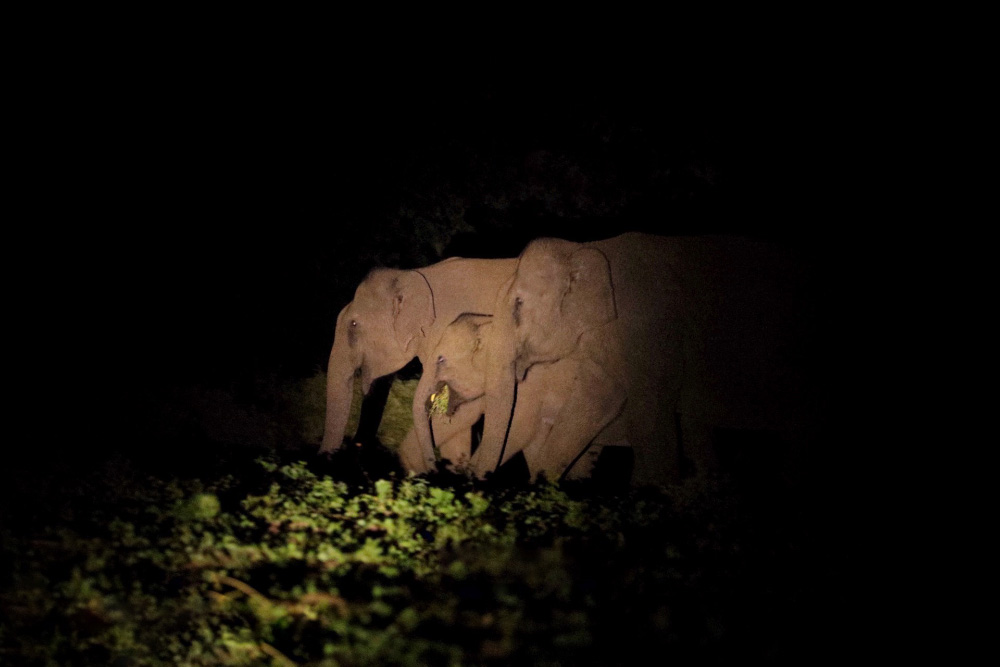
In the foothills of the Anaimalai Tiger Reserve (ATR) in Tamil Nadu, a couple of ‘mango showers’ mark the end of summer and herald the beginning of the monsoon. At this time, the private farmlands that adjoin the Tiger Reserve in the small village of Sethumadai are leased out by their owners to the local villagers – temporary tenant farmers, who work as daily laborers during the rest of the year. They plough the leased farmlands and sow the most preferred seasonal crop of the region – groundnuts.
As the plants take root and expand, the lessees erect watch sheds, locally known as Kaava Saalais. Constructed of dry coconut and Palmyra fronds, these sentry shacks act as shelters for those who stay up all night protecting the crops from wild animals.
The farmers are a close-knit community and rely on information that they share with each other regarding the movements of animals. Family members take turns to keep watch during the night, and avoid walking around or riding their bikes between dusk and dawn.
As the grey monsoon clouds gather above the mountains every evening, they light fires and get ready for the night’s vigil. The flickering flames are generally enough to keep elephants, gaur, sambar, wild boar, and even the occasional leopard, at bay. But, at times, when the fires don’t deter the elephants, these farmers never resort to fire crackers or other noise to frighten them. Instead, they simply use illumination. When bright lights are directed at the animals, they quietly retreat into the jungle.
Rather than fear wild animals, the farmers here are excited to spot them during their night watch, particularly, elephants. Sometimes, their wives and children come to stay in the sheds, in hopes of sighting the pachyderms. When I read about all the negative interactions between farmers and elephants in other parts of the country – even nearby Valparai – I wonder what makes it so different here.
As animals find new ways to raid crops, the farmers here come up with ingenious ways to ward them off. Recently, they’ve devised a method which entails tying a length of rope from one tree to another along the forest boundary where the wind blows quite hard. The noise created by the rope as it sways in the wind is quite loud and keeps animals away. One farmer hangs dry Palmyra fronds from a branch. When the branch moves in the wind, the frond is dragged noisily on the ground below. Typically, the solutions that these farmers come up with cause little or no harm. The people innately understand that the land they farm once belonged to the animals, and are content to share space with them.
While it heartens me to see such a peaceful co-existence, I’m worried about the next generation of farmers. Will they adopt the same tolerant attitude towards wildlife? Sadly, negative stereotypes in the media, especially about crop raiding elephants, often stokes the fires of hatred towards them. I can only hope that these farmers will pass down their wildlife wisdom to their heirs. If they do, Sethumadai can remain a wildlife paradise and a stomping ground to the most iconic animal of these forests – the elephant, after whom these very hills are named.

 CI is a non-profit, non-commercial portal that aims to facilitate wildlife and nature conservation by providing reliable information and the tools needed to campaign effectively.
CI is a non-profit, non-commercial portal that aims to facilitate wildlife and nature conservation by providing reliable information and the tools needed to campaign effectively.
Chosen as 'Picture of the Week'
On most occasions, elephants that enter the groundnut fields are gently deterred using a simple yet powerful tool - LIGHT!